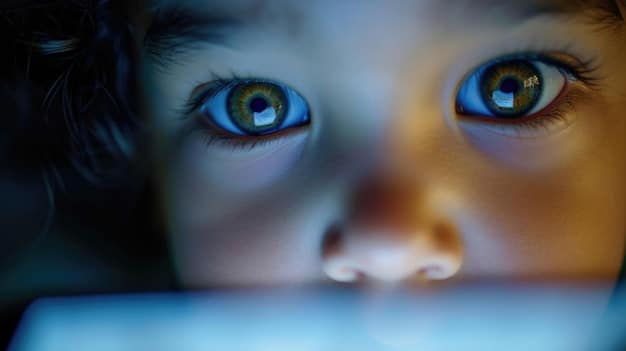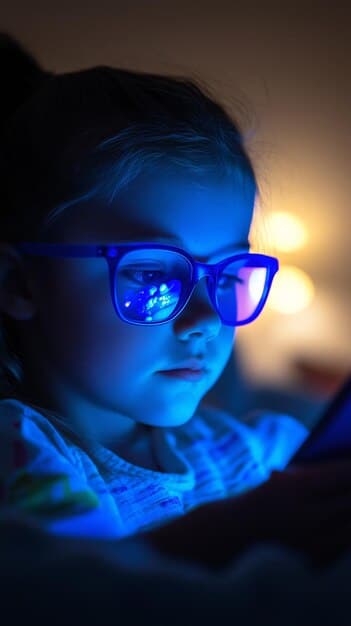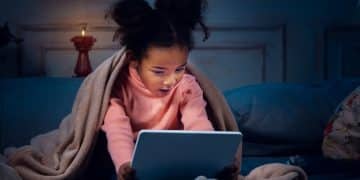Blue Light Blocking: Is It Harming Your Child’s Sleep? Research Alert

Recent research suggests that while blue light blocking glasses and screen filters are marketed to improve sleep, they might inadvertently disrupt a child’s natural sleep patterns by affecting melatonin production and circadian rhythm regulation.
Are you considering blue light blocking glasses or screen filters for your child to improve their sleep? Recent research raises concerns about whether **blue light blocking** strategies might actually be doing more harm than good. Let’s dive into the latest findings.
Understanding Blue Light and Its Effects
Blue light is a high-energy, short-wavelength light emitted by digital screens (smartphones, tablets, computers, and televisions) and LED lighting. It’s also present in natural sunlight. Understanding its effects is crucial before considering blue light blocking solutions for children.
The Science Behind Blue Light
Blue light affects our circadian rhythm, the body’s natural sleep-wake cycle. During the day, blue light helps us stay alert and awake. However, exposure to blue light in the evening can suppress melatonin production, a hormone that regulates sleep.
How Blue Light Impacts Children Differently
Children are more susceptible to the effects of blue light than adults. Their eyes are still developing, allowing more blue light to reach the retina. This increased exposure can lead to greater suppression of melatonin and potential sleep disturbances.

Here’s a quick breakdown of how blue light impacts children:
- Increased Alertness: Blue light can make children feel more awake and alert, even when they should be winding down for bed.
- Melatonin Suppression: Evening exposure can significantly reduce melatonin levels, delaying sleep onset.
- Circadian Rhythm Disruption: Irregular exposure can disrupt the natural sleep-wake cycle, leading to chronic sleep problems.
In conclusion, understanding the fundamental effects of blue light, especially on children, sets the stage for evaluating whether blue light blocking solutions are genuinely beneficial or potentially harmful.
The Promise of Blue Light Blocking: What’s the Hype?
Blue light blocking glasses and screen filters have gained popularity as potential solutions to mitigate the negative impacts of blue light on sleep. But what’s the hype surrounding these products, and do they live up to their promises?
How Blue Light Blocking Glasses Work
Blue light blocking glasses are designed with lenses that filter out or block blue light emitted from screens. They typically have an amber or yellow tint, which helps to reduce the amount of blue light reaching the eyes.
The Function of Blue Light Screen Filters
Blue light screen filters are software or physical overlays that reduce the amount of blue light emitted by digital devices. These filters can be adjusted to different strengths, allowing users to customize the amount of blue light being blocked.

Many believe these products offer several benefits:
- Improved Sleep Quality: By reducing blue light exposure, these tools are intended to allow for natural melatonin production and better sleep patterns.
- Reduced Eye Strain: Some users report less eye strain and fatigue, particularly after prolonged screen use.
- Overall Well-being: Advocates suggest these measures can contribute to better mood and focus by supporting a healthier circadian rhythm.
In short, the promise of blue light blocking lies in its potential to counteract the disruptive effects of digital screens, promoting better sleep and overall well-being. It’s this promise that has driven the popularity and widespread use of these products.
The Latest Research: Concerns About Children’s Sleep
While blue light blocking solutions seem promising, recent research has raised concerns, particularly regarding their impact on children’s sleep. These studies suggest that the blanket use of these tools might not be as beneficial as once thought.
Key Findings from Recent Studies
Several studies have investigated the effects of blue light blocking on sleep and circadian rhythms. Some key findings include:
- Inconsistent Results: Not all studies show a significant improvement in sleep quality with blue light blocking. Some studies report only marginal benefits.
- Potential for Disruption: Blocking blue light at the wrong time of day could disrupt the natural circadian rhythm, leading to further sleep problems.
- Impact on Melatonin: While blocking blue light can increase melatonin production in some cases, it may not always translate to improved sleep outcomes.
Expert Opinions and Warnings
Experts in sleep medicine and pediatrics are now cautioning against the indiscriminate use of blue light blocking, especially in children. They emphasize the need for a more nuanced approach.
Some experts argue that:
– Completely blocking blue light may interfere with the natural signals our bodies use to regulate the sleep-wake cycle.
– The timing of blue light exposure is critical; blocking blue light during the day could lead to daytime sleepiness or mood changes.
– Behavioral strategies, such as establishing a consistent bedtime routine and limiting screen time before bed, are often more effective and less disruptive.
Recent research underscores that the indiscriminate use of blue light blocking might inadvertently disrupt children’s sleep, necessitating a more cautious and tailored approach.
Why Blue Light Blocking Might Be Harmful
The potential harm of blue light blocking stems from its impact on the delicate balance of our circadian rhythm and melatonin production. When used inappropriately, these tools can disrupt these natural processes.
Disrupting the Natural Circadian Rhythm
Our circadian rhythm is fine-tuned by exposure to natural light throughout the day. Blue light, in particular, plays a crucial role in signaling wakefulness and alertness. Blocking blue light at the wrong times can confuse the body’s internal clock.
Interference with Melatonin Production
Melatonin production is naturally suppressed by blue light during the day and increases in the evening to promote sleepiness. While blocking blue light in the evening is intended to boost melatonin, doing so excessively or at inappropriate times can disrupt this natural pattern.
Here’s how blue light blocking can disrupt the circadian rhythm and melatonin production:
- Timing is Key: Blocking blue light during the day can reduce alertness and lead to daytime sleepiness.
- Over-Reliance: Over-dependence on blue light blocking tools can prevent the body from naturally regulating its sleep-wake cycle.
- Individual Variation: The effects of blue light blocking can vary from person to person, with some individuals being more sensitive to its impact.
In essence, the potential harm of blue light blocking arises from its capacity to disrupt the body’s natural mechanisms for regulating sleep and wakefulness, highlighting the necessity for judicious and informed application.
Safer Alternatives for Better Sleep in Children
Rather than relying solely on blue light blocking, there are several safer and more effective strategies for promoting better sleep in children. These alternatives focus on establishing healthy sleep habits and addressing underlying sleep issues.
Establishing a Consistent Bedtime Routine
A consistent bedtime routine signals to the child’s body that it’s time to wind down and prepare for sleep. This routine should be calming and relaxing, free from screens and stimulating activities.
Limiting Screen Time Before Bed
Reducing screen time in the hours leading up to bedtime is crucial. The blue light emitted from screens can make it harder to fall asleep, and the content can be mentally stimulating.
Consider these safer alternatives for better sleep:
- Reading: Read a book or tell stories in a dimly lit room.
- Bath Time: A warm bath can help relax muscles and promote sleepiness.
- Relaxation Techniques: Practice deep breathing, meditation, or gentle stretching.
Creating a Sleep-Friendly Environment
Ensure the child’s bedroom is conducive to sleep. This means creating a dark, quiet, and cool environment. Use blackout curtains to block out light, and consider a white noise machine to mask disruptive sounds.
In summary, prioritizing consistent routines, limiting screen time, and creating a conducive sleep environment offers safer, more holistic approaches to enhancing children’s sleep quality without the potential drawbacks of excessive blue light blocking.
Practical Tips for Responsible Blue Light Management
While concerns exist, it’s essential to know how to manage blue light exposure responsibly. Informed strategies can help minimize potential harm while still allowing for the benefits of digital technology.
When and How to Use Blue Light Blocking
If considering blue light blocking, timing is everything. Here are some guidelines:
- Evening Use Only: Use blue light blocking glasses or screen filters only in the evening, a few hours before bedtime.
- Avoid Daytime Use: Refrain from using these tools during the day, as blue light is necessary for alertness and mood regulation.
- Adjust Filter Strength: Experiment with different filter strengths to find what works best without causing daytime sleepiness.
Balancing Technology Use and Sleep Hygiene
It’s crucial to strike a balance between technology use and healthy sleep habits. Encourage children to engage in non-screen activities, especially in the evening.
Here’s how to manage technology use and sleep hygiene:
- Establish Tech-Free Zones: Designate certain areas, like the bedroom, as tech-free zones.
- Set Time Limits: Limit the amount of time children spend on screens each day.
- Model Healthy Habits: Parents should model healthy technology habits to set a good example.
In conclusion, responsible blue light management entails strategic timing, balanced technology use, and proactive sleep hygiene practices, ensuring children benefit from technology without compromising their sleep.
| Key Point | Brief Description |
|---|---|
| 💡 Blue Light Effects | High-energy light from screens can disrupt melatonin production and sleep patterns. |
| 👓 Blue Light Blocking | Glasses and filters reduce blue light exposure, but overuse can disrupt circadian rhythms. |
| 🌙 Safer Alternatives | Consistent routines, limited screen time, and a sleep-friendly environment are better. |
| 🛡️ Responsible Management | Use blocking tools strategically in the evening and balance with good sleep habits. |
Frequently Asked Questions
▼
When used correctly, blue light blocking glasses are generally safe. However, overuse or using them during the daytime can disrupt a child’s natural sleep-wake cycle, so moderation is key.
▼
There is no specific age recommendation, but they should only be considered for children who use screens extensively in the evening and after trying alternative sleep strategies.
▼
Limiting screen time, especially before bed, and using screen dimming apps can help. Additionally, creating a dark sleep environment and consistent bedtime routine will minimize blue light exposure.
▼
Yes, using blue light blocking at the wrong times or relying on it excessively can disrupt the natural circadian rhythm and interfere with melatonin production, potentially making sleep worse.
▼
Parents should establish good sleep habits, limit evening screen time, and consult with a pediatrician or sleep specialist if problems persist. Avoid solely relying on blue light blocking solutions.
Conclusion
In conclusion, while blue light blocking technologies offer a potential solution to screen-induced sleep disturbances in children, recent research suggests they should be approached with caution. Responsible use, combined with healthier sleep habits, is the best path forward for promoting restful nights and overall well-being.





